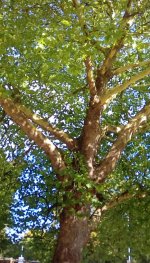Beech Lines


By markle
- 3932 reads
It’s a sight that encompasses many years, to look up the height of a tree from the root bole to the point where the twigs and leaves are splayed against the clouds. The copper beech at the junction of Woodstock and Plantation roads gives a fine opportunity to do this.
I realise, now I think about it, that I’ve barely ever looked at the garden it stands in, or the house. It’s the roots bursting out through the retaining wall above the pavement that catch the attention first. Years ago, when the tree was just a sapling, the wall must have run neatly straight down the garden edge. But now what seems a great weight of flesh, gleaming as with skin and bulging and folding, has broken through. It must still be growing, layer after layer being built up under the bark.
There is no firm line separating root from trunk. Here or there you might be able to point to a shift from smoother to more pitted bark, from twisting contours to a more regular cylindrical form, but the closer the inspection the less clear the point of transition.
Nonetheless, there is a transition, and the trunk rises up, far too broad for me to put my arms around. The bark has a dusting of green lichen, and seems set with many miniature ladders where the bark is cracked horizontally and vertically, like an arboreal echo of Dante’s Purgatory. Under here flow the tree’s fluids, earth to sky in the xylem and phloem. It seems quite an affront that someone at some time must have pinned notices here, and left the staples to rust into the flesh.
As the trunk rises so this fine detail begins to fade. The bark appears smoother, and only occasionally do patches of discoloration interrupt its even greyish-brown.
Another transition occurs: the branches begin to break out from the main stem, pathways that invite the eye to stray in all directions, but if you hold to the original line it continues as your head tilts further and further back, it arcs, and if the day is windy, sifts as though suggesting different answers to the same question. The bark seems paler and paler, the wood thinner and thinner, and then, like a moment of enlightenment it is no
longer branch but the canopy of leaves. All beech leaves are beautiful, but copper beeches are the finest. They keep the translucence of the usual green, but their dark purple transforms the light. Where the breeze parts them, clear sky darts through,
then is shaded again. When they fall they are a strange, crisp parchment, inviting luminous ink.
A tree like this has hosted millions, even billions of creatures, mostly invertebrates but also birds and small mammals over its many years. Whenever I pass it I stop and put my hand on the trunk, not far above the root bole. I always wonder if I will be able to feel the life in it, a sort of tree breath or tree pulse that has a different rhythm from that of the traffic in and out of Oxford. I haven’t felt it yet, but will keep trying.
First published in Oxford Magazine
- Log in to post comments
Comments
This skilful
slice of nature writing is our Facebook and Twitter Pick of the Day. Why not share or retweet if you like it too?
- Log in to post comments
Captivating description to
Captivating description to encouraging others to stop and look up at the swaying leaves and branch patterns agains the sky! Rhiannon
- Log in to post comments
enjoyed reading SO MUCH
enjoyed reading SO MUCH Thankyou!
Love everything about this - the detail, the rhythm the sense of time, the biology lesson, the images, how you tell where it is like it was a famous statue, though it has brought more pleasure and peace and usefulness to the planet than any human made thing
particularly liked how you describe the wall having been straight when tree was planted, also how leaves fallen are like luminous ink, and the leaves being an enlightenment,
- Log in to post comments
Very enjoyable description
Very enjoyable description here, especially since it's winter and I need reminding about those beautiful leaves glittering in the sunlight. Billions of creatures as you say, some trees are almost like planets.
- Log in to post comments
This is a wonderful piece of
This is a wonderful piece of writing. I can only admire your knowledge of this beech tree and hope that you keep trying to feel the rhythm in its pulse.
Beautifully mastered.
Jenny.
- Log in to post comments


